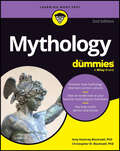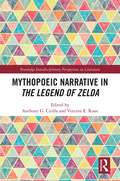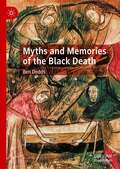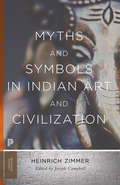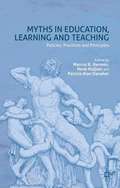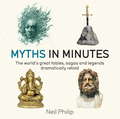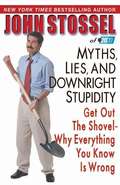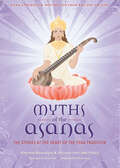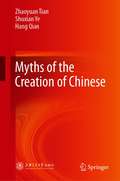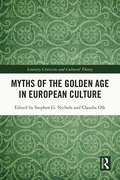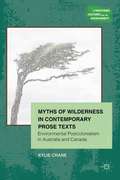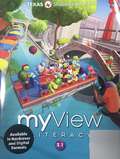- Table View
- List View
Mythology For Dummies
by Amy Hackney Blackwell Christopher W. BlackwellDiscover (or rediscover!) history’s greatest myths and legends From Grendel and Beowulf to Poseidon, Medusa, and Hercules, the gods, monsters, and heroes of mythology are endlessly weird and fascinating. And if you’re looking for a helpful companion to this wild collection of creatures, humans, and deities, you’ve found it! Mythology For Dummies delivers the straight goods on history’s most popular myths, helping you make sense of even the most complicated ancient stories. You’ll learn about the origins of your favorite myths, their cultural impact, and more. Discover: The coolest mythological characters, including intrepid Odysseus, the volatile gods of Mount Olympus, and Thor and Loki How ancient mythology intersects with our daily lives in pop culture, high culture, and everything in between Mythological destinations, like Atlantis, and famous sites from Greek, Roman, and Norse mythologyAn engrossing guide to some of the most enduring and interesting tales from throughout history, Mythology For Dummies serves up the inside scoop on almost every myth or legend you’d care to learn more about.
Mythopoeic Narrative in The Legend of Zelda (Routledge Interdisciplinary Perspectives on Literature)
by Anthony G. Cirilla Vincent E. RoneThe Legend of Zelda series is one of the most popular and recognizable examples in videogames of what Tolkien referred to as mythopoeia, or myth-making. In his essay On Fairy Stories and a short poem entitled Mythopoeia, Tolkien makes the case that the fairy tale aesthetic is simply a more intimate version of the same principle underlying the great myths: the human desire to make meaning out of the world. By using mythopoeia as a touchstone concept, the essays in this volume explore how The Legend of Zelda series turns the avatar, through which the player interacts with the in-game world, into a player-character symbiote wherein the individual both enacts and observes the process of integrating worldbuilding with storytelling. Twelve essays explore Zelda’s mythmaking from the standpoints of literary criticism, videogame theory, musicology, ecocriticism, pedagogy, and more.
Myths and Memories of the Black Death
by Ben DoddsThis book explores modern representations of the Black Death, a medieval pandemic. The concept of cultural memory is used to examine the ways in which journalists, writers of fiction, scholars and others referred to, described and explained the Black Death from around 1800 onwards. The distant medieval past was often used to make sense of aspects of the present, from the cholera pandemics of the nineteenth-century to the climate crisis of the early twenty-first century. A series of overlapping myths related to the Black Death emerged based only in part on historical evidence. Cultural memory circulates in a variety of media from the scholarly article to the video game and online video clip, and the connections and differences between mediated representations of the Black Death are considered. The Black Death is one of the most well-known aspects of the medieval world, and this study of its associated memories and myths reveals the depth and complexity of interactions between the distant and recent past.
Myths and Symbols in Indian Art and Civilization (Princeton Classics #111)
by Heinrich Robert ZimmerA landmark work that demystifies the rich tradition of Indian art, Myths and Symbols in Indian Art and Civilization analyzes key motifs found in legend, myth, and folklore taken directly from the Sanskrit. It provides a comprehensive introduction to visual thinking and picture reading in Indian art and thought. Ultimately, the book shows that profound Hindu and Buddhist intuitions on the riddles of life and death are universally recognizable.
Myths in Education, Learning and Teaching
by Marcus K. Harmes Henk Huijser Patrick Alan DanaherA myth empowers by providing a foundation story of a society, culture or civilization, bringing coherence and meaning to identity and underpinning custom. But 'myth' also carries darker meaning, suggesting ideas or practices that are fallacious or accepted uncritically. This book engages with these possible understandings of myths and uses them to interrogate educational practice and theory in three main areas: online teaching; language teaching; and specific tertiary or university based issues. The focus is on exploring and defining myths across a wide range of contexts and educational sectors. It brings together a broad range of senior researchers and middle-career and early-career scholars from the United Kingdom, North America, Europe, the Middle East and Australasia.
Myths in Minutes (IN MINUTES)
by Neil PhilipThe world's great fables, sagas and legends dramatically retold.Myths are the greatest stories ever told. Passed down over millennia, they are the templates for all our stories, with their eternal themes of creation and destruction, fate and cunning, heroism and cruelty, sensuality and war. Retold here are nearly 200 myths - from Prometheus defying Zeus to create man to the destruction of Troy; and from valiant battles against Frost Giants and Cyclopes to the heroic quests for the Golden Fleece and Holy Grail - including a commentary on their origins, common themes and meanings. Compellingly written, concise and with each myth illustrated with an iconic image, Myths in Minutes is the perfect way to understand and enjoy the world's major fables. Includes the great Ancient Greek, Roman and Egyptian legends: The Labours of Heracles; The Gods of Olympus; Zeus defeats the Titans; Hades and the Underworld; Theseus and the Minotaur; The Gorgons; Perseus and Andromeda; Oedipus and the Sphinx; The Judgment of Paris; The Trojan Horse; The Odyssey; Jason and The Golden Fleece; Romulus, Remus and the Founding of Rome; Mars, the God of War; The Eye of Ra; The Murder and Resurrection of Osiris; and more.The best of Celtic, Norse, Eastern, American, Oceanic and African myths: Gilgamesh and the Great Flood; Odin's Great Sacrifice; Thor's Adventures in the Land of the Giants; The Treachery of Loki; Ragnarok - The Last Battle; The Eight Immortals; The War Between the Sun and the Stars; Quetzalcoatl, The Plumed Serpent; Ganesh, the Elephant-headed; Ananse and the Sky God; King Arthur and the Knights of the Round Table; the age-old stories of the Aboriginal Dreaming; and many; many more.
Myths, Lies, and Downright Stupidity: Get Out the Shovel - Why Everything You Know is Wrong
by John StosselStossel explains that much of what we hear, and what the media say, are myths. And he backs it up.
Myths of the Asanas: The Stories at the Heart of the Yoga Tradition
by Alanna Kaivalya Arjuna van der KooijThe ancient lore behind yoga poses: “Transports us to a world where gods and goddesses, saints, and enlightened animals serve as our teachers.” —MC YogiPractitioners around the world reap the physical benefits of yoga, assuming poses frequently called by their Sanskrit names. While many know that hanumanasana is named for the deity Hanuman, few know why. But behind each asana and its corresponding movements is an ancient story about a god, sage, or sacred animal, much like Aesop’s fables or European folktales. Myths of the Asanas is the first book to collect and retell these ancient stories. The myths behind yoga’s spiritual tradition have the power to help students of all levels realize their full potential. Meditating on the tolerance of trees while standing in tree pose can help one become more tolerant. Learning how the disfigured sage Astavakra came to be the teacher of a king can liberate us from anxieties about our external appearance and our self-imposed limitations. Marveling at Hanuman’s devotion to Ram can serve as a source of spiritual strength and determination. With more than sixty beautiful illustrations to frame the stories, Myths of the Asanas will add a new dimension to your practice and study of yoga.“Truly enhances our yogic lessons. Some of the nuances of ethics, posture, breath, and meditation can only be touched through metaphor and mythology and we thank them for taking us on this journey.” —Rodney Yee, author of Moving Toward Balance
Myths of the Creation of Chinese
by Zhaoyuan Tian Shuxian Ye Hang QianDrawing on the sun, moon, dragon, phoenix, Nuwa, Yandi, Huangdi and other widely circulated cultural elements as examples, this book addresses the development and evolution of the most representative Chinese creation myths regarding nature, totems, ancestors and saints. The book not only interprets key creation myths, but also elaborates on the connection between the myths and some of the core values and concepts in Chinese civilization. For example, the long and jade culture is rooted in the Yellow Emperor’s revered jade weapon. Further, the book reveals the kernels of truth in the myths by presenting new research findings and research methods.
Myths of the Golden Age in European Culture (Literary Criticism and Cultural Theory)
by Stephen G. Nichols Claudia OlkHesiod’s concept of a Golden Age, together with analogous myths – Babylonian, Egyptian, Hebrew, etc. – speak to the psychic appeal, perhaps even deep-rooted need, for humans to conceive alternate worlds free from the anguish, toil, and dangers of the one they inhabit. Classical poets and philosophers explored the myth; the Middle Ages imagined it as the land of Cockaigne; Early Modern dramatists incorporated it; Romantic poets and nineteenth-century writers imagined it in various guises. This volume explores the configuration presented by Hesiod and the history of its reception and transformation in European literature and culture. The chapters study how texts written in specific historical moments of European history reshape elements of the myth to explore contemporary issues of concern. The book addresses these issues of cultural hybridization, and, from a transhistorical perspective, provides new insights into the dynamics of epochal shifts. It also looks at similar configurations in non-Western civilizations (China), which complements the spectrum of contributions that covers periods from classical antiquity to the Age of Goethe.
Myths of Wilderness in Contemporary Narratives
by Kylie CraneThe concept of 'wilderness' as a foundational idea for environmentalist thought has become the subject of vigorous debates. Myths of Wilderness in Contemporary Narratives offers a taxonomy of the forms that wilderness writing has taken in Australian and Canadian literature, re-emphasizing both country's origins as colonies.
myView Literacy 1.1: Student Interactive
by Julie Coiro Jim Cummins Pat CunninghamNIMAC-sourced textbook <p>Grade 1
myView Literacy 1.1 Student Interactive
by Julie Coiro Jim Cummins Pat CunninghamNIMAC-sourced textbook
myView Literacy 1.2: Student Interactive
by Julie Coiro Jim Cummins Pat CunninghamNIMAC-sourced textbook <p>Grade 1
myView Literacy 1.2 Student Interactive
by Julie Coiro Jim Cummins Pat CunninghamNIMAC-sourced textbook
myView Literacy 1.3 Student Interactive
by Julie Coiro Jim Cummins Pat CunninghamNIMAC-sourced textbook
myView Literacy 1.4 Student Interactive
by Julie Coiro Jim Cummins Pat CunninghamNIMAC-sourced textbook
myView Literacy 1.5 Student Interactive
by Julie Coiro Jim Cummins Pat CunninghamNIMAC-sourced textbook
myView Literacy 2.1 Student Interactive
by Julie Coiro Jim Cummins Pat CunninghamNIMAC-sourced textbook
myView Literacy 2.1 Student Interactive
by Julie Coiro Jim Cummins Pat CunninghamNIMAC-sourced textbook
myView Literacy 2.2 Student Interactive
by Julie Coiro Jim Cummins Pat CunninghamNIMAC-sourced textbook
myView Literacy 2.2 Student Interactive
by Julie Coiro Jim Cummins Pat CunninghamNIMAC-sourced textbook
myView Literacy 4.1 Student Interactive
by Julie Coiro Jim Cummins Pat CunninghamNIMAC-sourced textbook
myView Literacy 4.1 Student Interactive
by Julie Coiro Jim Cummins Pat CunninghamNIMAC-sourced textbook
myView Literacy 4.2 Student Interactive
by Julie Coiro Jim Cummins Pat CunninghamNIMAC-sourced textbook
